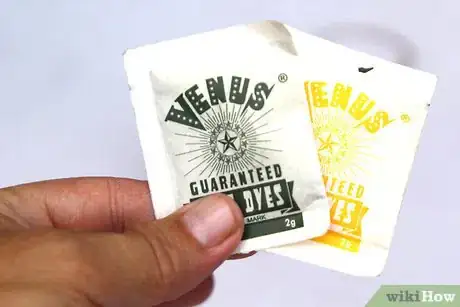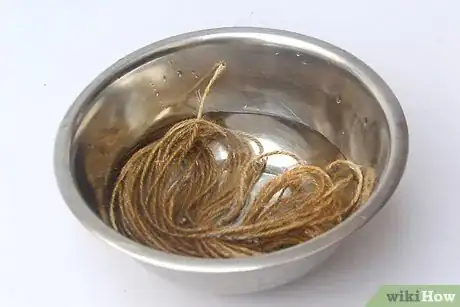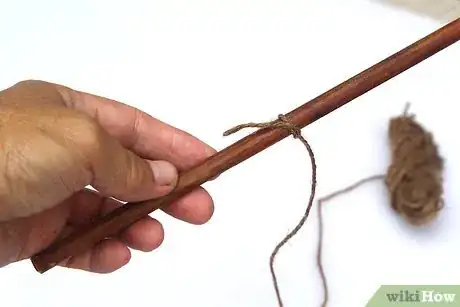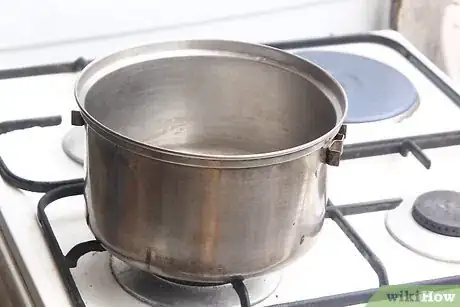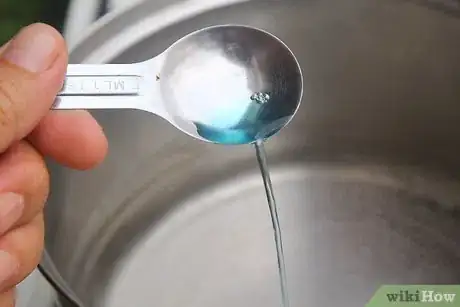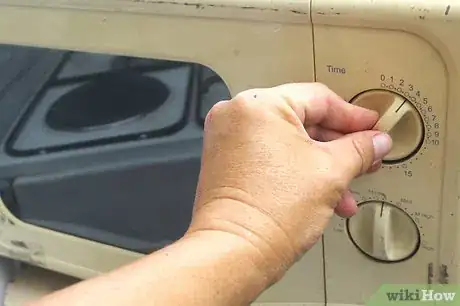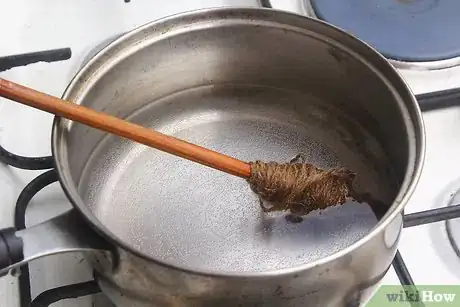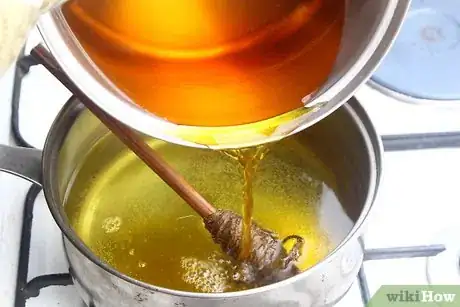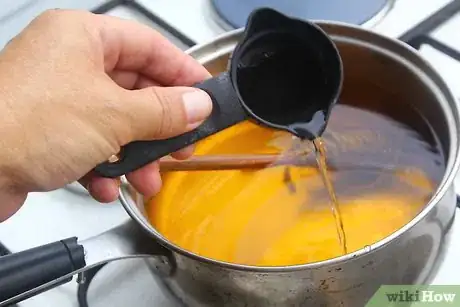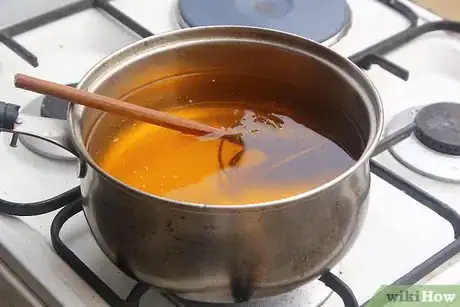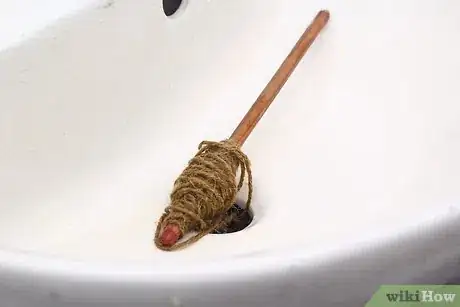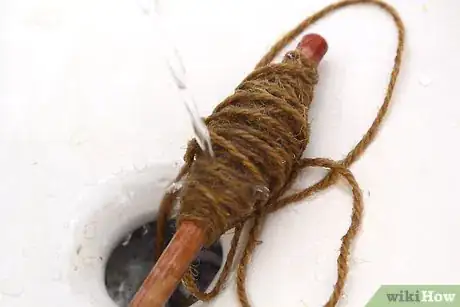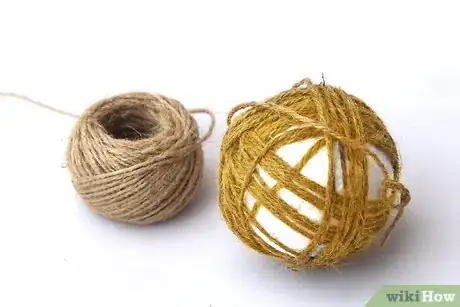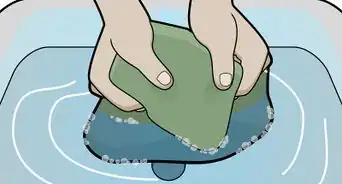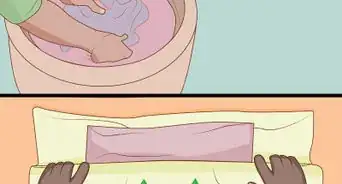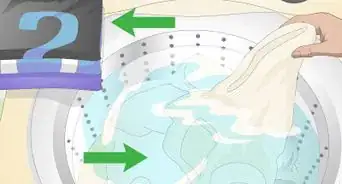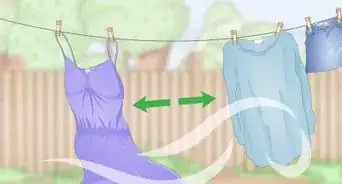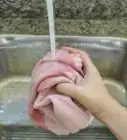X
This article was co-authored by wikiHow staff writer, Hunter Rising. Hunter Rising is a wikiHow Staff Writer based in Los Angeles. He has more than three years of experience writing for and working with wikiHow. Hunter holds a BFA in Entertainment Design from the University of Wisconsin - Stout and a Minor in English Writing.
This article has been viewed 36,074 times.
Learn more...
Jute rope is a fun decoration to add to your household. Though many are sold in a natural brown tone, changing the color to create an accent piece is something you can do. With a few household ingredients and some fabric dye, you can make a colorful craft that is bound to draw some attention.
Steps
Part 1
Part 1 of 3:
Preparing the Materials
-
1Use direct dye packets, like Rit or iDye. These sorts of dyes will have a better effect on natural materials, such as jute or hemp. Many of these products will come in dissolvable powder packets so they can be easily added and mixed.[1] The dye can be purchased in hobby stores or online.
- Direct dyes are also available in liquids to help better control the amount you are adding.
-
2Unravel and presoak the rope under warm water until it is wet throughout. This process better prepares the rope to accept the dye. Wring out the rope as best as you can, leaving it a little damp.[2]
- Wet fabrics will hold color better than dry material.[3]
Advertisement -
3Tie a small dowel to the end of the rope. This dowel will help you later on when you want to re-wrap the rope. It will also keep the end of the rope out of the pot to avoid it from getting tangled.[4]
- Use a simple knot to attach the rope to the center of the dowel.
-
4Fill a large pot 2/3 full of water and bring it to a boil. Direct dye activates with heat. First, bring your water to a low boil. After it is boiling, bring the water down to a simmer.[5]
- Use a pot different from one that you cook in, as the dye may stain and leave residue that should not be consumed.
-
5Add 1 tbsp (15 mL) of dish soap to the water. The addition of dish soap to your water will help the dye spread throughout the pot and coat the rope evenly. Slowly stir in the soap to avoid bubbles.[6]
-
6Microwave 2 cups (470 ml) of water in a measuring cup until it boils. You’ll use this water to mix your dye before adding it to the pot. Keep it separated from the boiling water in the pot.[7]
-
7Add the dye packet to the microwaved water and stir until it completely dissolves. Use as much as the dye packet as you want to reach the desired color. Using the full packet will give you a more vibrant color.[8]
- The colors will be much deeper if using jute rope that is a natural brown color. Consider using an ivory rope if you want a color truer to the dye you’ve prepared.
- Test the dye on a paper towel to get an idea of how the final color will turn out.
Advertisement
Part 2
Part 2 of 3:
Dying Your Jute Rope
-
1Place the rope in the pot of simmering water. Wrap the end of the rope tied to the dowel around the handle of the pot to avoid more tangles and knots. In the end, you’ll be able to cut off this undyed portion of the rope.[9]
- Make sure the rope is completely submerged so all areas are dyed and that it can move freely in the pot.[10]
-
2Pour the dye mixture into the pot. Slowly pour the measuring cup of dye and microwaved water into the simmering pot. Be mindful of splashing the dye, as this will stain clothes and certain materials.[11]
- As you add the dye, use a wooden or plastic spoon to stir the pot.
-
3
-
4Let the jute rope simmer for 30 minutes on low. With the heat setting on low, let the rope rest in the water for 30 minutes.[14] Stir consistently with a wooden or plastic spoon to evenly spread the dye.
Advertisement
Part 3
Part 3 of 3:
Cleaning the Rope
-
1Dump the water and rope into a sink. Drain the water carefully into a clean sink. Avoid letting the water splash. It’s okay if the rope falls into the sink too since you will have to rinse the excess dye from it.[15]
- Wear rubber gloves and an apron to protect your skin and clothes from stains.
-
2Rinse the rope with warm water, slowly changing the temperature to cold. Run warm to hot water over the rope and squeeze away the excess dye. Over time, change the water from hot to cold. Continue this process until the water running through the rope is clear.[16]
- If the color is too dark, continue using warm water until you reach your desired color. Only when you’re happy with the color should you switch to cold water.
-
3Wring out the rope and re-wrap it. Once the excess dye is removed, wring out the remaining water from the rope. Loosely re-wrap the rope around the dowel and let it hang to dry.[17]
- As the rope dries, it may lighten in color. Leave the color a little darker than what you want to account for this.
Advertisement
Warnings
- Wear rubber gloves during the processes involving dye to avoid staining your skin.⧼thumbs_response⧽
Advertisement
Things You’ll Need
- Large pot
- Measuring cup
- One packet of direct dye
- Small wooden dowel
- Dish soap
- Vinegar
- Wooden or plastic spoon
- Rubber gloves
- Apron
References
- ↑ http://blog.wardrobesupplies.com/2014/05/21/home-fabric-dyes-101/
- ↑ http://www.onecrazyride.com/how-to-dye-twine/
- ↑ http://www.ssww.com/blog/tricks-and-tips-for-tie-dying/
- ↑ http://www.onecrazyride.com/how-to-dye-twine/
- ↑ http://www.onecrazyride.com/how-to-dye-twine/
- ↑ https://www.ritdye.com/instructions/stovetop/
- ↑ http://www.onecrazyride.com/how-to-dye-twine/
- ↑ http://www.onecrazyride.com/how-to-dye-twine/
- ↑ http://www.onecrazyride.com/how-to-dye-twine/
- ↑ https://www.ritdye.com/instructions/stovetop/
- ↑ http://www.onecrazyride.com/how-to-dye-twine/
- ↑ http://www.onecrazyride.com/how-to-dye-twine/
- ↑ http://www.pburch.net/dyeing/FAQ/vinegar_for_dyeing.shtml
- ↑ http://www.onecrazyride.com/how-to-dye-twine/
- ↑ http://www.onecrazyride.com/how-to-dye-twine/
- ↑ http://www.onecrazyride.com/how-to-dye-twine/
- ↑ http://www.onecrazyride.com/how-to-dye-twine/
- ↑ http://stowandtellu.com/how-to-dye-confessions-of-a-burlap-newbie/
About This Article
Advertisement
